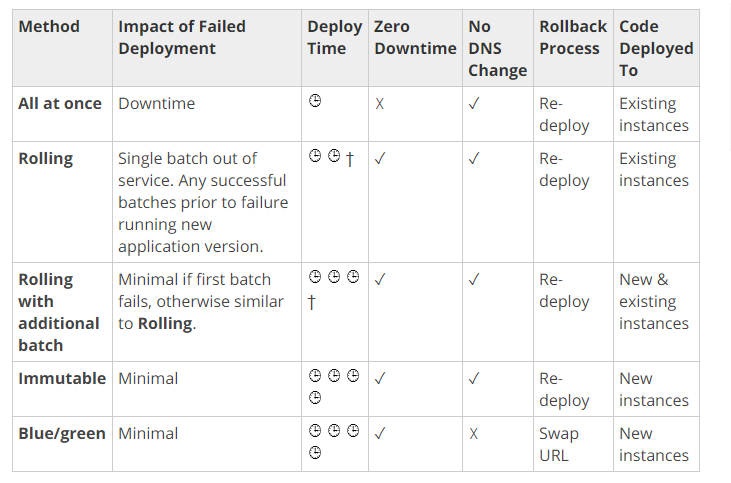Fastest Deployment Approaches for Elastic Beanstalk Environments
Question
Your company has an application hosted on an Elastic beanstalk environment.
You have been instructed that whenever application changes occur and new versions need to be deployed that the fastest deployment approach is employed.
Which of the following deployment mechanisms will fulfil this requirement?
Answers
Explanations
Click on the arrows to vote for the correct answer
A. B. C. D.Answer - A.
The following table from the AWS documentation shows the deployment time for each deployment methods.
For more information on Elastic beanstalk deployments, please refer to the below link:
http://docs.aws.amazon.com/elasticbeanstalk/latest/dg/using-features.deploy-existing-version.html
Elastic Beanstalk is an AWS service that makes it easy to deploy, manage, and scale applications in the AWS Cloud. It supports various deployment mechanisms such as All at once, Rolling, Immutable, and Rolling with batch.
- All at Once:
This deployment mechanism deploys the new version of the application to all instances simultaneously. This is the fastest way to deploy, but also the riskiest as it can cause application downtime if something goes wrong. This approach may be suitable for small applications that can tolerate downtime and have a small number of instances.
- Rolling:
This deployment mechanism deploys the new version of the application to a subset of instances at a time. Once the new version is deployed and stable, it moves to the next subset of instances until all instances have the new version deployed. This approach reduces the risk of downtime as it deploys the new version gradually, but it takes longer than the all-at-once approach.
- Immutable:
This deployment mechanism creates a new set of instances with the new version of the application, tests them, and then swaps the old instances with the new instances. This approach is the safest, as it does not modify the existing instances and allows for rollbacks in case something goes wrong. However, it takes longer than the other approaches as it involves creating a new set of instances.
- Rolling with Batch:
This deployment mechanism is similar to Rolling, but it deploys the new version of the application in batches. This approach is useful for applications with a large number of instances and can reduce the risk of downtime.
To fulfill the requirement of the fastest deployment approach, the "All at once" deployment mechanism would be the most appropriate. However, this approach may not be suitable for all applications, as it may cause downtime. Therefore, it is essential to assess the application's tolerance to downtime and choose the appropriate deployment mechanism accordingly.